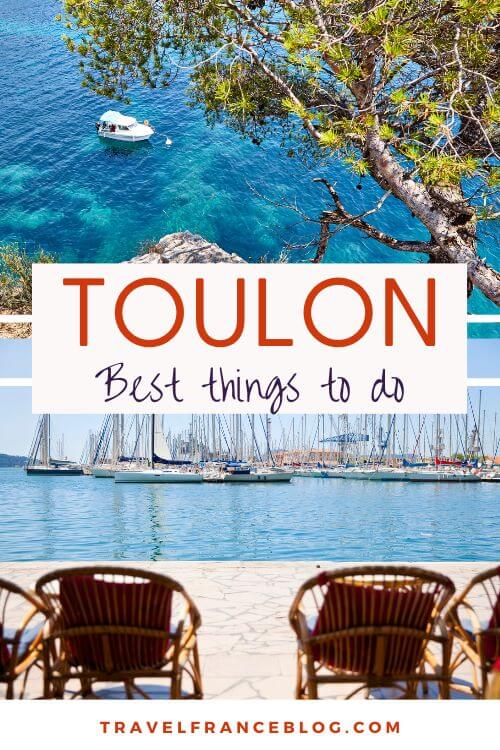Iconic Landmarks & Monuments in the South of France
Are you interested in the history of France? Besides heading to the most popular destinations in the heart of the country, you can get to know the most important people and historical events from the monuments in the South of France.
- Plan your trip to the South of France with this travel planner.
- Get 5% off travel insurance when visiting the South of France.
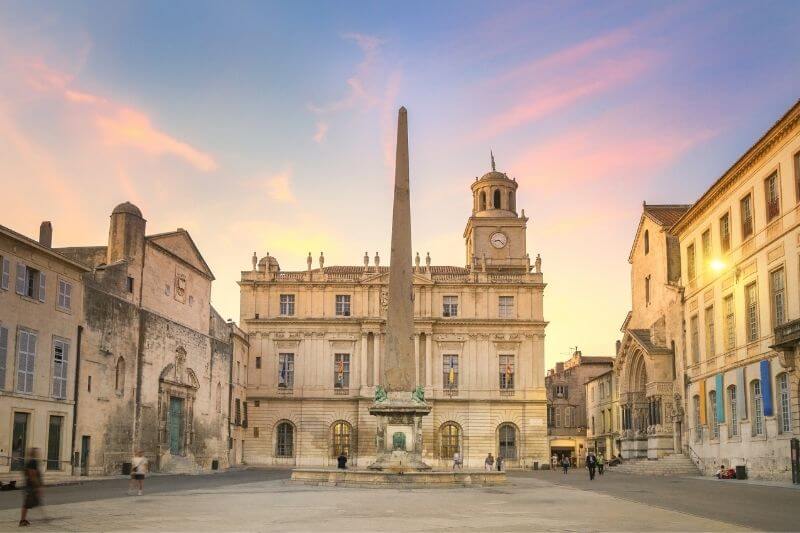
Statues and Monuments in South of France
There number of statues and monuments in south France is huge, most of which are UNESCO World Heritage sites too. Sadly, you will not be able to stop by all of them.
But when you can stop, we strongly suggest going on a walking tour with a guide, if it’s available, to get a deep dive into the people and monuments’ stories.
Monuments are not just statues. Some of them are buildings and entire walled cities or more.
While some monuments are only available for a visit, others are still used for exhibitions, concerts, etc., until today. Here are some of the most popular and favorite monuments we recommend visiting on your trip to the South of France.
Pont du Gard Aqueduct Monument
Located 35 minutes Northeast of Nîmes, the Pont du Gard is the most visited ancient monument in France.
Pont du Gard is a magnificent ancient Roman aqueduct bridge located in Occitania, France. It is considered one of the most impressive and well-preserved examples of Roman engineering and architecture in the world.
The bridge is part of the aqueduct that was built in the first century AD to transport water from Uzès to the city of Nîmes, through a distance of over 50 km.
The Pont du Gard is a three-level bridge that spans the Gardon River. The bottom level consists of six arches that allow the river to flow underneath the bridge. The middle level is made up of eleven arches, while the top level has thirty-five arches.
The bridge is made of limestone blocks that were quarried from nearby hills and assembled without the use of mortar.
The Pont du Gard is not just a functional engineering marvel, but it is also considered as a work of art. The arches are perfectly proportioned and the symmetry of the structure is awe-inspiring.
The bridge is also surrounded by beautiful natural scenery, including the river and the hills.
Today, the Pont du Gard is a popular tourist attraction and a UNESCO World Heritage site since 1985. Visitors can walk across the bridge, explore the surrounding area, and learn about the history and engineering behind this amazing structure.
The Pont du Gard is a testament to the skill and engineering capacity of the ancient Romans, and a must-see destination for anyone visiting Occitania. I can’t help to remember the Segovia Aqueduct that we have visited many times as well.
The Pont du Gard is 12 km from Uzès, a beautiful city and historic village that we strongly recommend visiting.
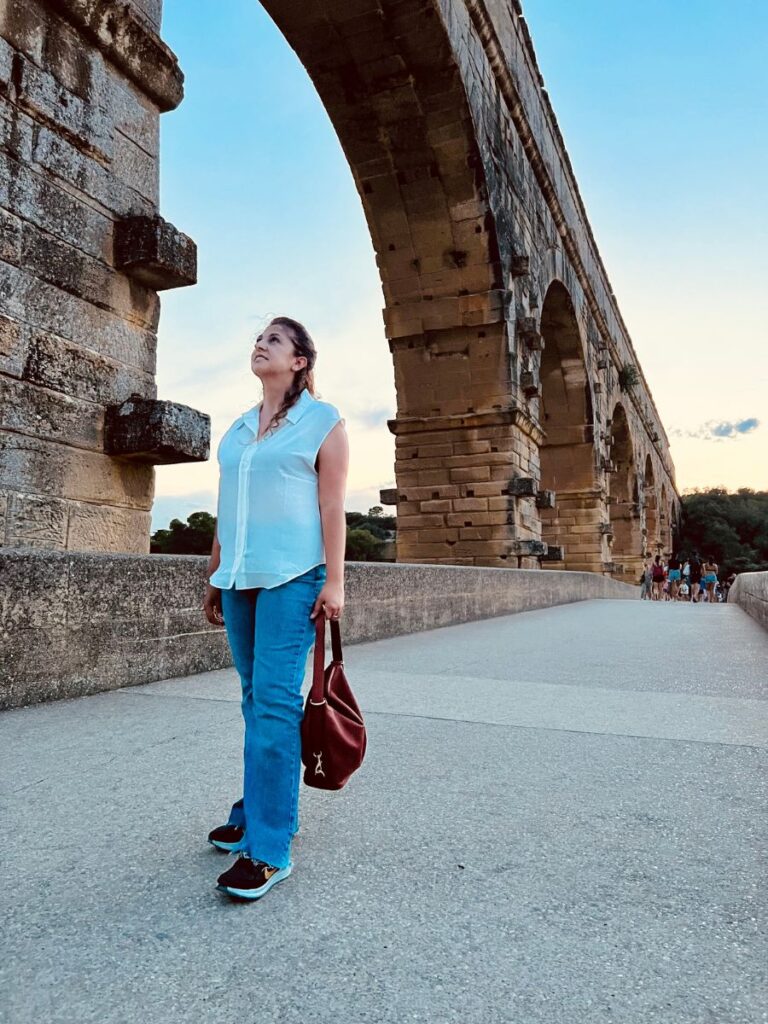
The Roman-built aqueduct assisted the people of Nimes in transporting water across the Gard River. You can book a ticket online here.
Vauban Fortifications
If you drive an hour west of Perpignan towards Spain, you’ll enter the Catalan Pyrenees Regional Nature Park and come across Villefranche-de-Conflent.
It’s a beautiful village built with pink marble and is considered one of the most beautiful in France. It’s located in the steep valley of the Têt River, and you can tell that Sébastien Le Prestre, Marquis of Vauban, was a total genius for figuring out how to build it so perfectly into the natural landscape.
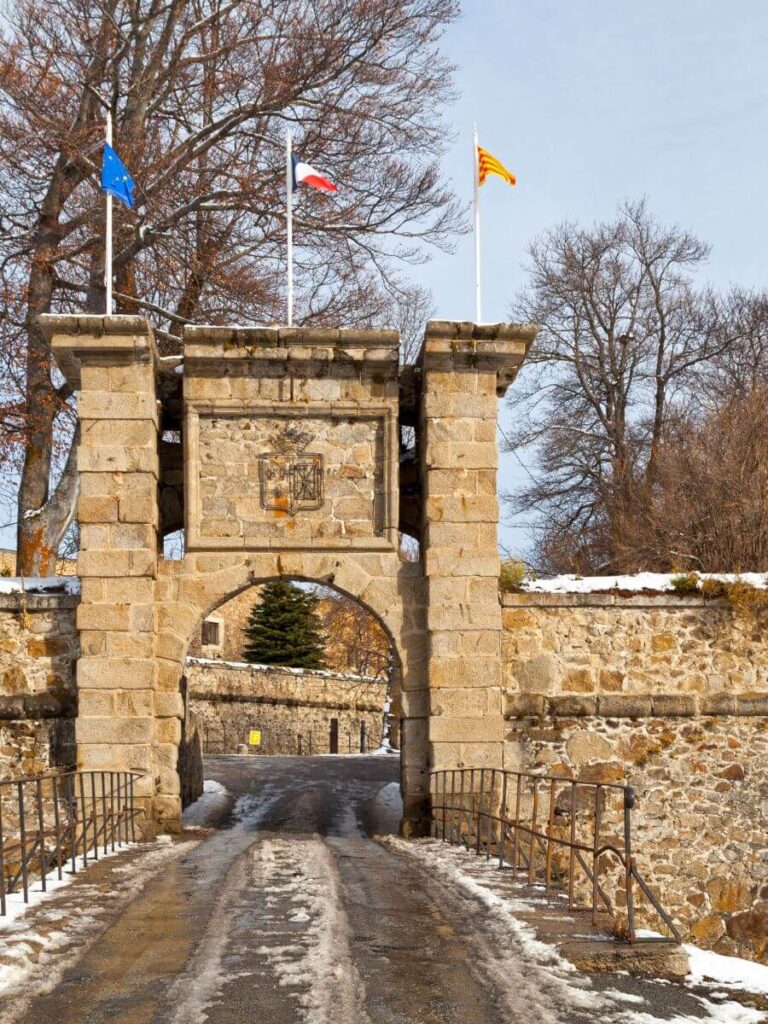
The Vauban fortifications in Occitania are a series of 12 military structures that were built by the famous French military engineer, Sebastien Le Prestre de Vauban, during the 17th and 18th centuries.
These fortifications were built in response to the constant threat of invasion from neighboring countries and were designed to protect France’s borders and maintain its territorial integrity.
The Vauban fortifications in Occitania include a number of impressive structures, such as the Citadelle de Mont-Louis, the Fort de Salses, and the Fort Saint-Elme.
Three of them are known as the Catalan trio, Mont-Louis (cité du roi soleil), Villefranche-de-Conflent and Fort Liberia.
These structures were built using innovative engineering techniques and were designed to be virtually impenetrable. They were equipped with state-of-the-art weaponry and were manned by highly trained soldiers.
Today, the Vauban fortifications in Occitania are popular tourist attractions and are recognized as UNESCO World Heritage sites since 2008.
You can get to Villefranche-de-Conflent and Mont-Louis on the famous Yellow Train, which has been running since 1910 and is an icon of the Catalan Country.
It’s a great way to make lasting memories while traveling between the citadels of Vauban, enjoying the stunning landscapes.
You can explore the impressive structures, learn about the history of the fortifications, and gain a deeper understanding of the military strategies and tactics that were used to protect France’s borders.
The Vauban fortifications in Occitania are a testament to the ingenuity and skill of Sebastien Le Prestre de Vauban and to the importance of military defense in the history of France.
They are a fascinating and educational destination for anyone interested in monuments, military history, and engineering.
The Episcopal City of Albi and the Albi’s Cathedral
The Episcopal City of Albi is a stunning UNESCO World Heritage site since 2010, located in the Occitania region of France.
It is named after the city’s impressive cathedral, the Cathédrale Sainte-Cécile, which dominates the skyline with its imposing Toulouses’s brick facade and bell tower and It’s the largest brick Cathedral in the world.
The city of Albi is known for its well-preserved medieval architecture, including the Palais de la Berbie, which was once the residence of the bishops of Albi.
The Episcopal city was built in the 13th century around the cathedral and the bishop’s residence the Palais de la Berbie.
The palace now houses the Toulouse-Lautrec Museum, which is dedicated to the works of the famous artist, Henri de Toulouse-Lautrec, who was born in Albi.
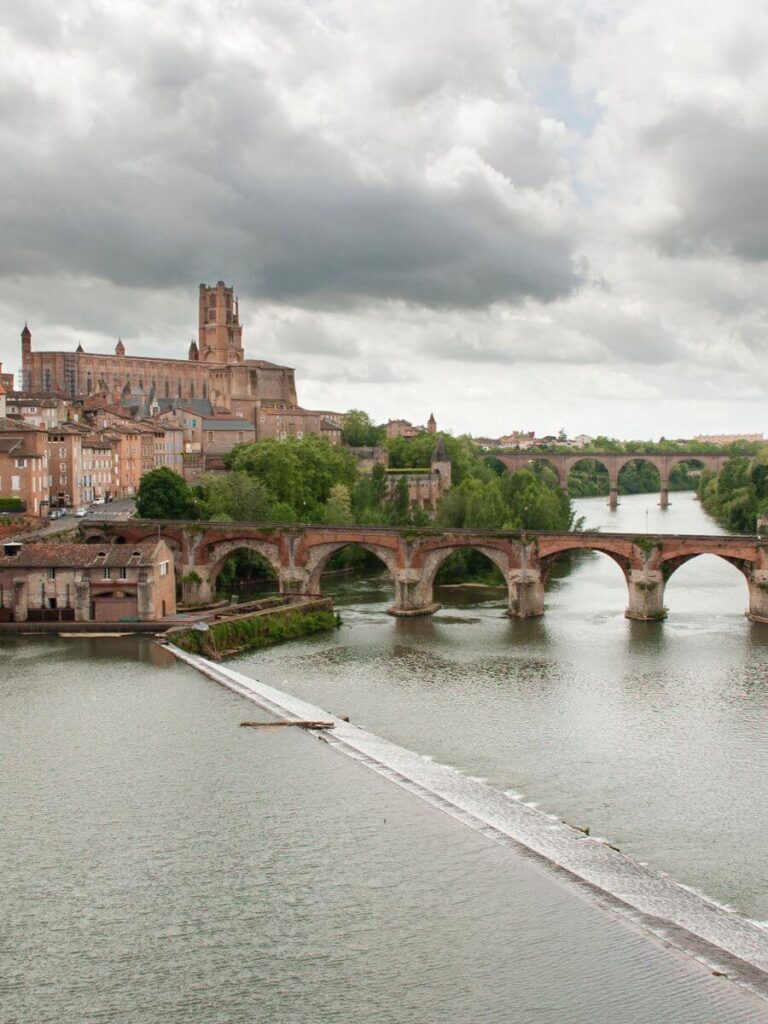
In addition to the cathedral and the palace, the Episcopal City of Albi is home to a number of other impressive buildings, including the Saint-Salvi Collegiate Church, the Pont Vieux, and the Maison Enjalbert.
The city’s narrow, winding streets and charming squares are also a delight to explore.
Visitors to the Episcopal City of Albi can take a guided tour to learn about the city’s rich history (in french) and architecture, or simply wander the streets and take in the sights and sounds of this beautiful city. W
Whether you’re interested in art, history, or simply enjoying the ambiance of a charming medieval city, the Episcopal City of Albi is a must-see destination in Occitania.
When visiting the Episcopal City and Albi’s Cathedral, we absolutely recommend you stop at the Toulouse Lautrec Museum.
Trophy of Augustus (Tropaeum Alpium) Monument in South France
The Trophy of Augustus is a monument located in La Turbie, commemorating Emperor Augustus’ victory over the Liguarians over 2000 years ago. The Liguarians had attacked merchants along trade routes.
It is still one of the most visited monuments in Southern France today. The Tropaeum Alpium was a monument and a fortress that Louis XIV turned into a quarry in the 16th century.
People, particularly husbands, would go to the Trophy of Augustus if they suspected their wives of infidelity and sought the oracle’s advice.
Triumphal Arch of Orange and Orange Amphitheater
The Orange Amphitheater is still used today for shows and concerts. With its open design, people can easily view any show scheduled for the day. During the Roman Empire, it was also used for performances. It was one of Emperor Augustus’ proudest monuments.
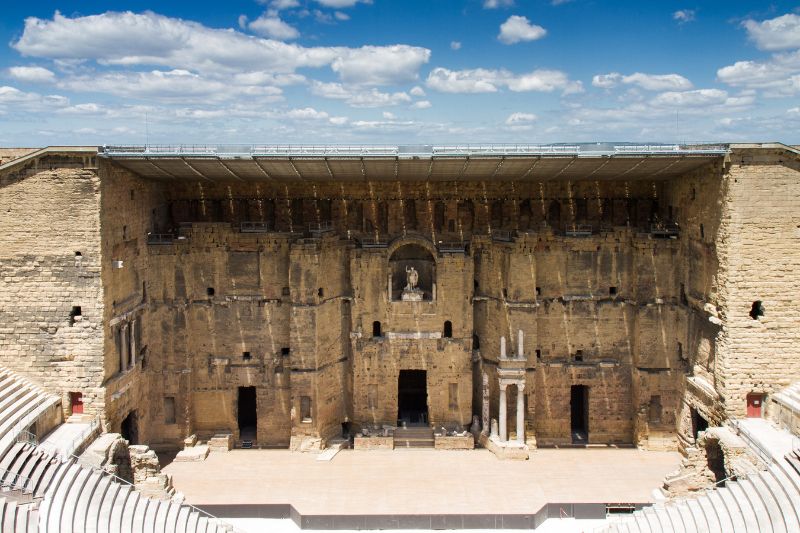
The Triumphal Arch of Orange is just a few steps away from the Orange Amphitheater. It is one of the Triumphal Arch all over France and was made during the reign of Emperor Augustus.
We recommend staying here and watching a show. You can find tickets and schedules here.
Maison Carrée
The hexastyle of the Maison Carrée in Nimes is a monument building you may have seen in several Greek temples. Are you familiar with the Aphaia at Aegina? The Maison Carree also has a facade of six columns.
The Maison Carrée was built to honor the goddess Roma, and Gaius and Lucius. They were patrons of colonia along with their mother, Julia, the daughter of Agrippa and Augustus.
Like the Tropaeum Alpium, it also went through a change of use. The Visigothic kings used the Maison Carrée as an extension of their palace.
You can climb the stairs and take a photo at the entrance, but you can appreciate its beauty more from the outside. A couple of restaurants surround the monument too, so if you get hungry, you can sit down, admire this beautiful Roman architectural wonder, and eat.
Pont Saint Benezet
Among the monuments in the South of France, Pont Saint Benezet has one of the most intriguing stories. In the 12th century, Bénezet, a shepherd, built the bridge.
According to legend, the Bénezet heard voices instructing him to construct the Saint Bénezet bridge. Unfortunately, only four of the 22 arches survived to this day. The World Heritage site is still a popular tourist destination.
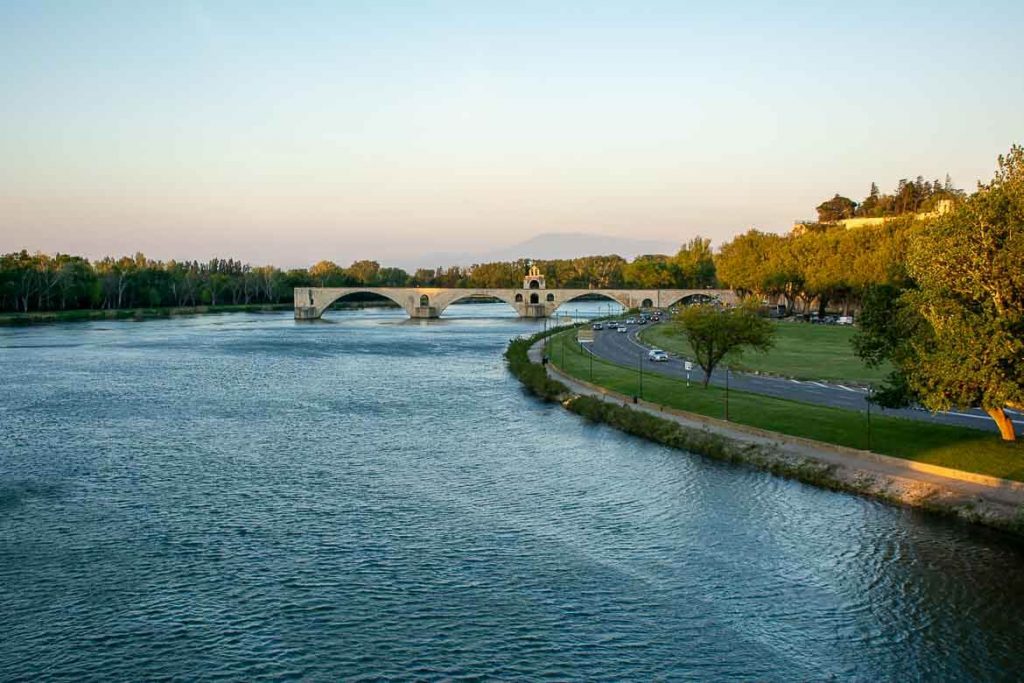
Over 300,000 people visit the Pont Saint Benezet each year, and you may find yourself surrounded by several of them on the bridge. Make the most of your visit by taking in the Rhône River and walking around town.
Arenes de Nimes
The Arenes de Nimes amphitheater is another must-see for epic shows. People cheered on people hunting animals and watched gladiator fights here in the first century AD.
The Arenes de Nimes has been well preserved and continues to host concerts. As a traveler, you can also admire the arena’s architecture, history, and multimedia shows about the Arenes de Nimes.
Roman Theater of Arles
The Arles Arenas or Arles Amphitheater has two tiers capable of seating 20,000 people. It was once a place for entertainment like hand to hand combats and chariot races.
The Roman Amphitheater of Arles is also oval like most arena monuments mentioned in this list. Today, the Roman Arenas still hosts concerts and other shows.
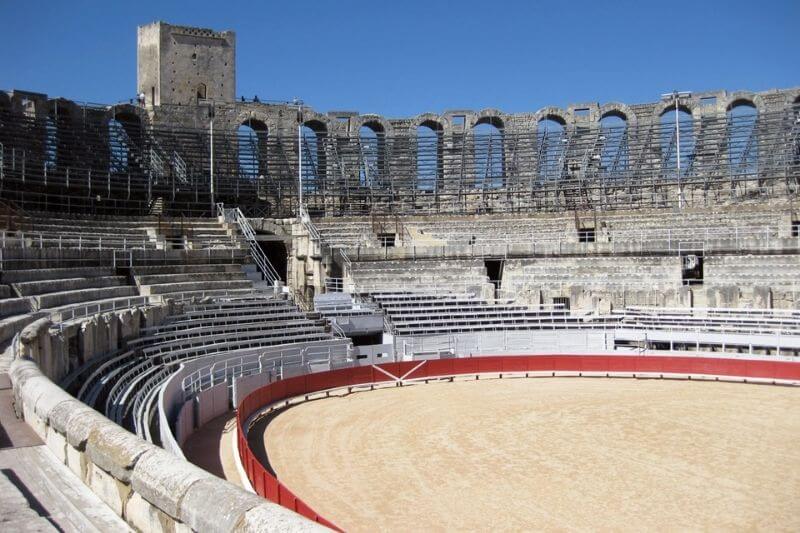
Constantine’s Baths
The spa complex in Arles is another monument along the Rhone River. People completed and used it during Constantine I’s reign early 4th century. You can still see the remains of the baths today.
Eglise St. Trophime
The interior of the Eglise St. Trophime may be one of the most exciting we’ve ever seen in a church. While some old churches have sculptures on their facades, you can find them inside Arles’ Eglise St. Trophime.
The Last Judgment sculpture is the church’s main attraction and an iconic example of Roman sculpture. The small but high windows and low collateral aisles are some of the distinctive features of the church.
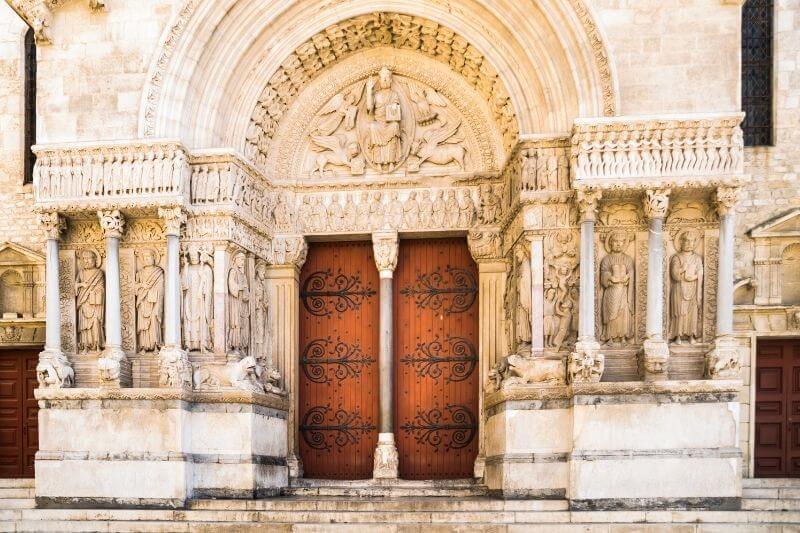
Les Alyscamps
Les Alyscamps is a one-of-a-kind monument in the south of France. It is a necropolis and has been the main burial ground in Arles for over 1,000 years.
Many people were buried here, including Arles’ first bishop, Saint Trophimus. The toms are said to be stacked up to three layers deep.
It also served as a source of inspiration for Vincent van Gogh and Paul Gauguin’s paintings. In October 1888, they went to the necropolis and painted side by side.
Roman Ruins of Vaison-la-Romaine
Vaison-la-Romaine is a medieval city in southern France, specifically Provence. However, you can only see the village’s ruins. Only two public access points are available: Puymin and La Villasse.”
It is also close to the Théo Desplans Archaeological Museum, which houses everyday object collections, the House of the Wreathed Apollo, and the Maison à la Tonnelle.
Several times, the city was rebuilt. On the remnants, you can even see the 20-year evolution of the town. While visiting, you can also enjoy a glass of good wine and cheese.
The Tour Magne in Nimes
Tour Magne is one of the remaining creations under the reign of Augustus. The towers were used during the Hundred Years’ War to defend against the English.
At the top of Tour Magne, you can see the trade routes. Then, the tower was used as a telegraph relay station in 1832 and was vital in sending letters. Nowadays, it has become one of the monuments visited by many.
After restoring the interior of Tour Magne, you can climb the 140 steps up to the top and see the panoramic views for Nimes.
Castle, Cathedral, and Abbey Monuments in South of France
Castles, abbeys, and other religious icons are also among the monuments in the South of France. If you enjoy palaces and other architectural marvels as much as I do, here are some monuments to visit during your trip.
Chateau d’If
Chateau d’If was once a famous castle with some of Marseille’s most beautiful views. It is perched atop a limestone island, making it an intimidating setting for a state prison. It housed inmates such as Philippe Égalité and the mysterious Man in the Iron Mask, imprisoned by Louis XIV in 1524.
It was already well-known for its inmates, but its popularity skyrocketed after the publication of The Count of Monte Cristo in 1844, a story about a sailor who was wrongfully imprisoned for 14 years and made the most daring escape.
Explore the Chateau d’If and other museums in Marseille with a city pass.
Carcassonne Fortress
The Porte Narbonnaise, Porte Saint-Nazaire, Porte d’Aude, and Porte de Rodez are the four gates of the Carcassonne Fortress. You can book the Carcassonne Fortress tickets online in advance.
The Porte Narbonnaise is the most popular entry point for tourists, but it also has large towers, whereas the Porte Saint-Nazaire has a defense system with fortified doors, machicolation, and pitfalls.
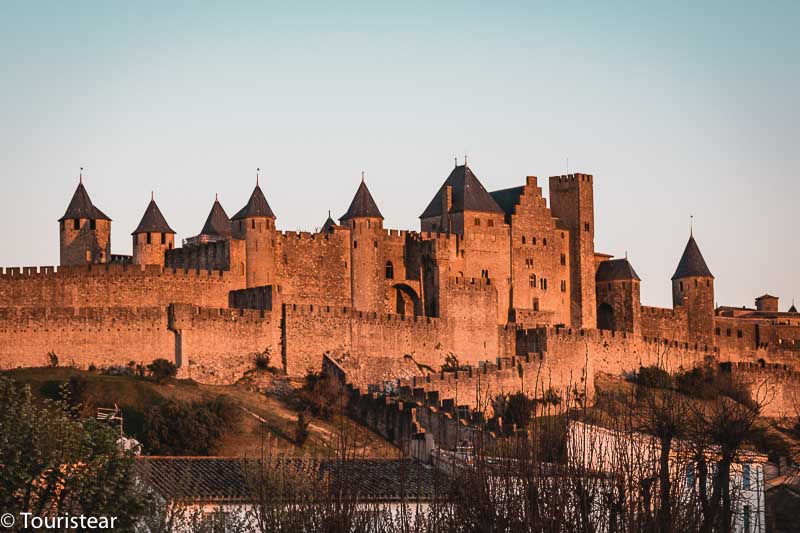
The Porte d’Aude has false passages to trap enemies as you travel west. The Porte de Rodez served as a trade route entrance on the castle’s northern side. Get to know more about the Fortress with a guided tour.
Berbie Palace
The palace has a large garden where visitors can walk around and relax, and the Toulouse-Lautrec Museum exhibits drawings, lithographs, and other works by several contemporary artists.
Despite being the site of the ancient bishops’ palace, it has seen and survived sieges. It represents the city’s religious and military power.
Berbie Garden features terraces and a spatial design in the old French style, with hedges and blooming flowers. Visit during the spring season to see the most beautiful views of the garden. There are also statues of the four seasons and Bacchus.
Basilica Saint-Sernin
The church honors the first bishop of Toulouse, Saint Saturnin. The church showcases the wide naves and wooden canopy with gold leaf and marble. The tympanum shows the Ascension of Christ with the angles and the twelve apostles made in Pyrenean marble.
The crypts and tower house the relics of saints that attracted many pilgrims. I recommend checking the tower during your trip.
Palais des Papes
The UNESCO World Heritage Site, known as the Pope’s Palace, is one of Avignon’s largest medieval architectural wonders. It also features Gothic details and the 14th-century Pope’s residence.
The Great Chapel, Banquet Hall, Papal Bedroom, and Grand Tinel are all must-see rooms in the Pope’s Palace.
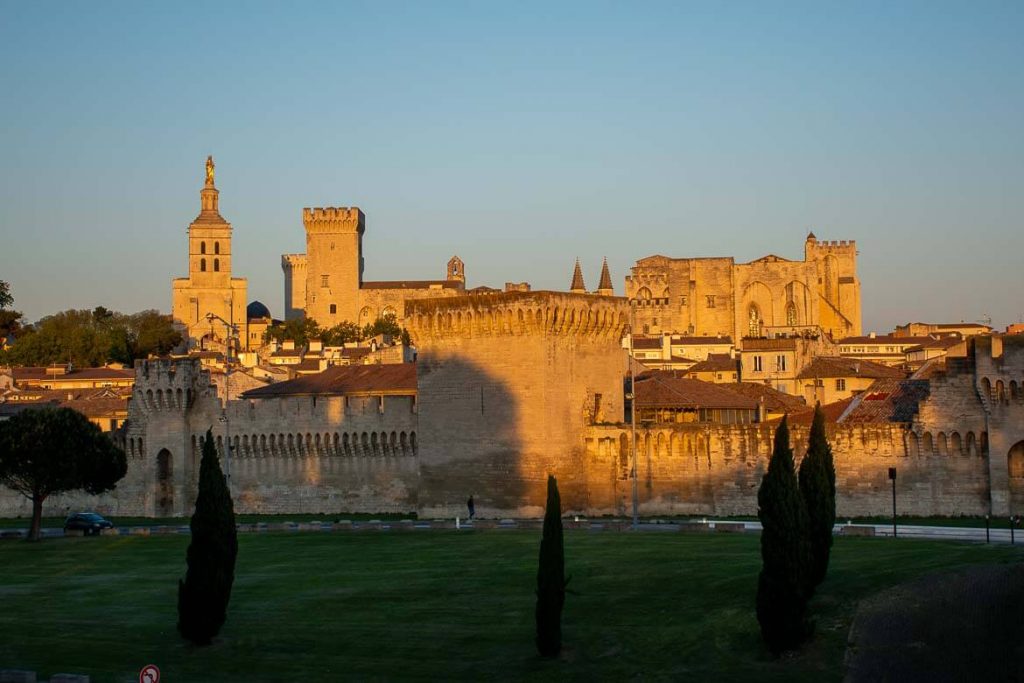
Lyon Cathedral
Lyon also has a Cathedral that combines Roman and Gothic architectural details. As we entered through these huge oak doors, we were welcomed by the stunning clock. The windows are adorned with rose stained glass dating back to the 12th century.
Convent of the Jacobins
The Dominican monastery was built with bricks and the same process as most cathedrals in the kingdom of France. It is also one of France’s most important symbols of the southern Gothic wonders.
The St Thomas Aquinas relics found inside the Convent symbolize Pope Urban V’s support to the preachers in introducing the people to their religion. Today, the relics are still inside the church.
Sadly, the Convent no longer hosts masses, but you may be lucky enough to see exhibitions. We were amazed at the high ceilings and high glass windows.
Abbey de Montmajour
The Abbey de Montmajour is adorned with a Romanesque facade and details and is a home of monastic life. It was the Benedictine monks that founded the monastery in 948. Despite being a religious building, it was fortified with watchtowers.
You can join art exhibitions held in the church occasionally or visit the monk cemetery nearby. The abbey also offers views of the Alps, which even Vincent van Gogh admires.
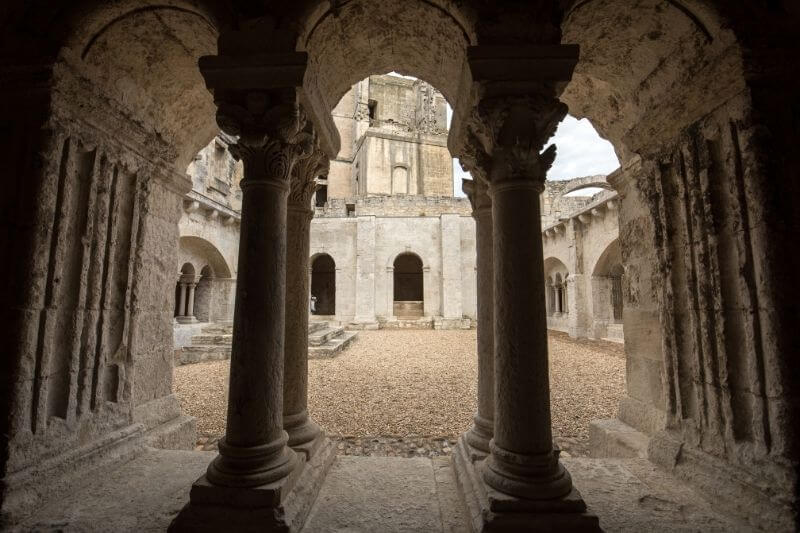
Cathar Castle Ruins
Found on a rocky top in the village of Lastours, you can find the Châteaux de Lastours. The Cathar castles are four castles named Cabaret, La Tour Regine, Quertinheux, and the Surdespine. The Quertinheux is separated from the other three castles.
The Cabaret has the barbican defense system, while the La Tour Regine is the smallest among the four but has the largest cistern. The Surdespine is known for its semicircular arched windows and being the least maintained. The one on the rocky outcrop is the Quertinheux castle.
The Duke’s Castle
The Duchy of Uzè has experienced a series of ownership transfers. It was built to be a home of Antoine de Crussol before it was sold, misused, and then used as a school.
Finally, it was restored and became the home of the current Duke of Uzès, Jacques de Crussol d’Uzès. He is the 17th Duke in line and has continued to take good care of the Duchy of Uzè.
It is still a private home, so you can only visit a few places in the castle.
Les Baux Castle
Another castle monument that offers a panoramic view of the Alpilles is the Les Baux Castle. Situated at the rocky top, it sees the Les Baux de Provence village. The castle’s ruins remain, and travelers can wander along them.
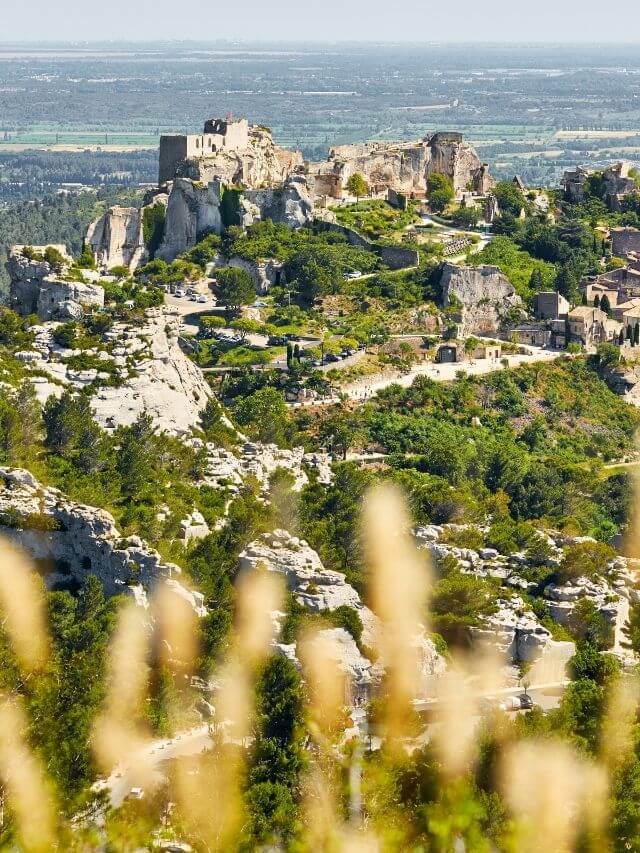
Palais Idéal
A castle monument you should visit is the Palais Idéal. It was the creation of the eccentric Ferdinand Cheval. Without knowledge of architectural designs, he spent 33 years and used stones and pebbles.
Ferdinand Cheval was a French mail carrier who dreamed of creating this wonder for years. Today, it is one of the most unique monuments in the South of France. You can find inspiration from different cultures from Cambodia, Egypt, and India all over the castle.
Senanque Abbey
The Notre-dame de Senanque Abbey is one of the wonders of Provence. The abbey was built in a Cistercian style architecture consisting of a church, cloister, a heated room, and a chapter house.
The Notre-dame de Senanque Abbey continues to house monks and has withstood several challenges in maintaining it and the wars of religion during the 17th century when monks were hanged.
It continues to represent Cistercian architecture and farms Lavandin, a hybrid of true lavender and lavender aspic. We recommend visiting the place from the end of June to see them in full bloom. By late July, they harvest the Lavandin to produce essential oils.
If you want to visit other Lavender fields including the one in the Senanque Abbey, you can book a Lavender Day Tour here.
How to Get to See Monuments in the South of France?
Guided tours often pick you up from a certain place to get you to your destination, but if you want to travel at your own pace, rent a car to visit these renowned monuments.
Another way to get to Southern France is via a train station. Book a flight to Paris, France. From Charles de Gaulle airport, take the train to the Avignon train station.
You can also hop on a flight to Marseille and ride the local train.

Getting to the South of France
You can easily tour the different cities in the South of France with a rental car. See the French countryside or drive along the Monaco Grand Prix route for fun.
Riding the train can get you to different rural areas. Some routes also pass into the mountains and over the Italian border, offering beautiful views that locals see.
If you only stay in one place, tour on foot or ride a bicycle. Ask locals for recommendations and find hidden gems yourself.
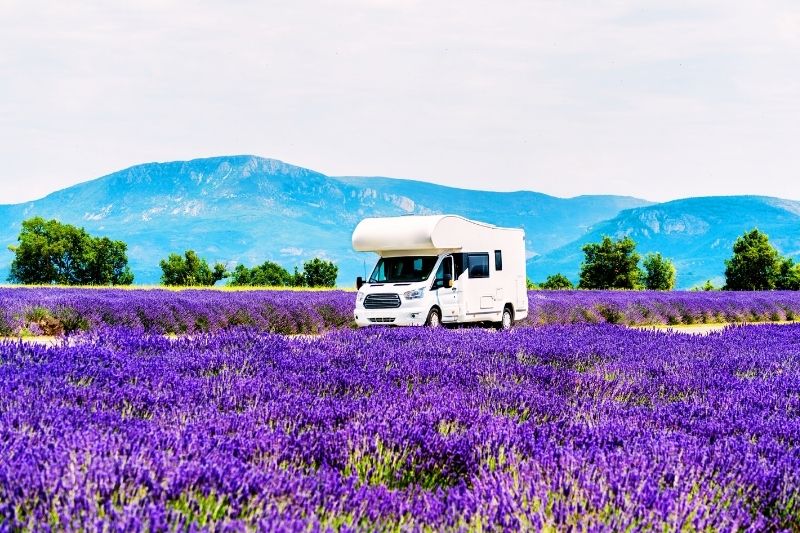
Day Trips to See Monuments in South of France
Full-Day Roman Sites and Historical Places
There are several Roman historical sites in the area. Furthermore, the majority of them are UNESCO World Heritage Sites. The guided tour includes admission to the Orange Amphitheater, transportation in an air-conditioned minibus, and an audio guide.
Private Walking Tour to See Monuments in South of France
The private 2-hour guided walking tour of Nimes will introduce you to the city. See the magnificent Amphithèatre, the Temple of Diane, and other Roman structures and bridges.
How Many Monuments Are There in France?
If you think the South of France has so many monuments to see, the whole country of France has over 40,000 official monuments! It has a lot compared to other countries in Europe.
Travel Insurance for the South of France
Planning to visit all the monuments in South of France? You have to go to several places to complete the whole tour, and for long and short vacations, we always prepare ourselves for emergencies.
Make sure to get travel insurance and make your South of France trip safe and memorable. Click on the link to get a 5% OFF.
Plan Your Trip to the South of France
- Accommodation in Provence’s UNESCO World Heritage Villages
- Road Trip Itinerary 10 days in Provence
- Weekend Getaways in the South of France
- Best Things To Do in the South of France in October
- How to Drive in the South of France
- Best Things To Do in Les-Baux-de-Provence, South of France
- 5-star Hotels in Provence

This post may include affiliate links. This means that we will receive a small commission if you make a purchase through our links. It has no additional cost for you. With this, you help us to continue creating free content for you.
This post may include affiliate links. This means that we will receive a small fee if you make a purchase through our links. It has no additional cost to you. It’s a win-win!



